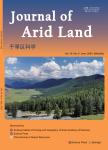Soil surface roughness change and its effect on runoff and erosion on the Loess Plateau of China
Soil surface roughness change and its effect on runoff and erosion on the Loess Plateau of China作者机构:College of Natural Resources and Environment Northwest A&F University
出 版 物:《Journal of Arid Land》 (干旱区科学(英文版))
年 卷 期:2014年第6卷第4期
页 面:400-409页
核心收录:
学科分类:0710[理学-生物学] 0830[工学-环境科学与工程(可授工学、理学、农学学位)] 0709[理学-地质学] 08[工学] 0708[理学-地球物理学] 0815[工学-水利工程] 0705[理学-地理学]
基 金:supported by the National Natural Science Foundation of China (41271288 41371273)
主 题:tillage practice soil surface roughness overland flow water erosion Loess Plateau
摘 要:As an important parameter in the soil erosion model, soil surface roughness(SSR) is used to quantitatively describe the micro-relief on agricultural land. SSR has been extensively studied both experimentally and theoretically; however, no studies have focused on understanding SSR on the Loess Plateau of China. This study investigated changes in SSR for three different tillage practices on the Loess Plateau of China and the effects of SSR on runoff and erosion yield during simulated rainfall. The tillage practices used were zero tillage(ZT), shallow hoeing(SH) and contour ploughing(CP). Two rainfall intensities were applied, and three stages of water erosion processes(splash erosion(I), sheet erosion(II) and rill erosion(III)) were analyzed for each rainfall intensity. The chain method was used to measure changes in SSR both initially and after each stage of rainfall. A splash board was used to measure the splash erosion at stage I. Runoff and sediment data were collected continuously at 2-min intervals during rainfall erosion stages II and III. We found that SSR of the tilled surfaces ranged from 1.0% to 21.9% under the three tillage practices, and the order of the initial SSR for the three treatments was ZT〈SH〈CP. For the ZT treatment, SSR increased slightly from stage I to III, whereas for the SH and CP treatments, SSR decreased by 44.5% and 61.5% after the three water erosion stages, respectively, and the greatest reduction in SSR occurred in stage I. Regression analysis showed that the changes in SSR with increasing cumulative rainfall could be described by a power function(R2〉0.49) for the ZT, SH and CP treatments. The runoff initiation time was longer in the SH and CP treatments than in the ZT treatment. There were no significant differences in the total runoff yields among the ZT, SH and CP treatments. Sediment loss was significantly smaller(P〈0.05) in the SH and CP treatments than in the ZT treatment.



